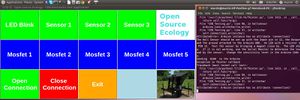CEB Press/Manufacturing Instructions/Control Source Code v1.0 Explained
| |||||||||||||||||||||||||
Introduction
Last updated August 25, 2011.
Notes: Orientation of CEB machine is defined by machine user facing the control panel, where the control panel is located to the left of the secondary cylinder attachment to the secondary arms. 3 magnets (sensor actuators) are used for main cylinder, 3 magnets for soil drawer. (2 magnets are are used for soil grate shaker sensor, optional and discontinued in 2011). Copyright April 2010, Creative Commons CC-BY-SA-compatible Open Source Ecology (OSE) License, by Marcin Jakubowski, Ph.D., for OSE.
This code and other documentation is available at the Open+Pario project management site under the CEB Project, under Documents - Liberator Beta 2.0 Control Code, http://openpario.net/projects/OSE.
Changes since v1.0
The 2011 production run features controller boards produced by Blair Evans of the Detroit Fab Lab. This particular board results in modifications to the code, in that the threshold values read by the Arduino from the Hall Effect sensors are 80 instead of 500.
That should be the only change, and the new source code is here: http://openpario.mime.oregonstate.edu/documents/1251
Code Testing Procedure
Upon receipt of a CEB machine, the following procedure should be followed in preparation for field use:
- Identify orientation of position magnets.
- Adjust position of sensor holders.
- Connect controller to battery power and connect control Arduino to a control computer
- Test solenoid valves manually with CEB Testing program - without hydraulic power
- Test solenoid valves manually with CEB Testing program - with hydraulic power
- Test automatic motion of secondary cylinder alone.
- Test automatic motion of main cylinder alone.
- Test full motion of the machine without soil
Magnet Orientation
Upon receipt of the machine, the position supermagnets should be in their correct position. If they have been moved during shipping, they need to be stuck onto the magnet holder in the correct (+ and -) orientation with respect to the north or south pole facing up or down.
To orient the magnets - use the indicator lights in the circuit as suggested in CEB_Press/Manufacturing_Instructions/Controller_Box#Testing_from_Zero - in particular - steps 9-17. This test should be done without live hydraulic power.
To orient the magnets, test the sensors with th e controller testing interface (Fig. 1) by pressing on the Sensor 1 or Sensor 2 button.
The high side of the magnet (+) will be identified when the corresponding sensor LED blinks. This must be done for both the primary and secondary cylinder sensors.
There are 3 position magnets for each sensor. These should be oriented such that the + faces of the magnets are on the outside, and the - face is in the middle. This applies to both sensors.
Sensor Holder Position
- Adjust the sensor holder so that the sensor tube is about 1/8" away from the magnet. The orientation of the sensor tube does matter - the side marked with a line should be the upper face of the Hall Effect sensor. If the marking is absent, test the orientation with the Controller Testing GUI.
-- OSECEBTest2.pde - This is testing code for the secondary cylinder. This code moves the secondary cylinder between the 3 magnet locations, stopping for 1 second at each location.
Battery Power and Arduino Hookup
- Connect the alligator clip power leads to the battery. The white wire is + of the battery, and the black wire is - of the battery. Polarity matters - you will burn out the controller if the polarity is reversed. NOTE: polarity reversal protection should be included in future versions.
- Connect the USB cord from the control computer to the Arduino
Manual Testing of Solenoid Valves
- Use the GUI (see CEB_Press/Manufacturing_Instructions/Controller_Box#Testing_from_Zero) to test the solenoid valve. Test each channel of the solenoid valve by itself, to make sure that it is activated. Proper activation is determined by: (1) an audible click of the solenoid inside the valve; and (2), lighting up of the corresponding indicator light on both the solenoid driver board and the solenoid itself. Each solenoid should display a green light on the top solenoid and a red light on the bottom solenoid.
